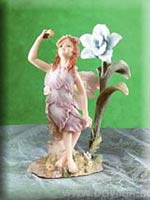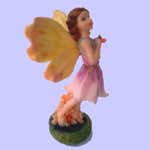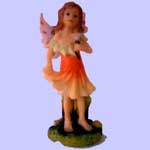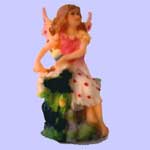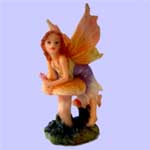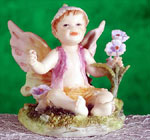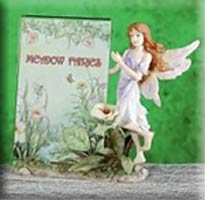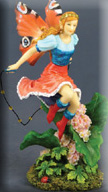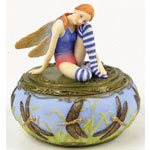A History
of Fairy Lore
The Enchantment of Fairies
By
Lillian Glockson
From the beginning of time man has believed that fate was
not entirely in his own hands, but also in the hands of
all-powerful beings, residing within an alternate dimension,
separated from our perception of time and space.
The entities believed to inhabit that plane of existence
have been countless. A very large and heavy book would be
required to recount all of their names, not to mention the
variations on their names in different countries. Let it
suffice to give only generalized references within this
article for the sake of brevity.
Even
to this day there are people who continue to believe in
those elusive masters of destiny, and who continue to perform
rituals meant to appease, just in case, for fear of the
consequences of not believing.
Although people
of every continent have embraced the supernatural at one
time or another, to the point of worshiping those entities
they thought would favor them, there has been an effort
by some to abolish all other beliefs but their own. Through
disinformation they have reshaped the public sentiment,
to transform the once benevolent into malevolent creatures
that evoke fear rather than reverence.
Such was the fate
of the Fay: The fairies of the Seely Court and the fairies
we know as nature spirits.
In an unpredicted
twist of circumstances, their fortunes came to rest in the
hands of humankind rather than the reverse
Where did they
come from? Were they just imaginings that took on an existence
of their own? Were they a race that is now extinct? Are
they still with us? These questions have never been conclusively
answered. Nonetheless, for the humans who share in the passionate
love of nature that fairies epitomize, and who wish to do
all they can to preserve its balance, it does not matter.
They are alive in the hearts of those who believe, and life
would not be complete without their stewardship.
Because fairies
were very real to so many of our ancestors, it is difficult
to know for sure whether or not the many tales about them
were grounded in some truth. Most people now feel that fairy
stories were just flights of fancy, but there is strong
evidence in literature that they were either a popular tool
for scaring children or enhanced accountings of actual events.
Perchance they were both. Reports of recent sightings are
rare, but fantastic rumors of fairy encounters were once
numerous and quite descriptive.
The fairies of legend
have always been with us under one name or another. Whether
or not they were ever real, it is well documented that great
caution was always used when referring to fairy-kind. The
names they were called by, such as "Gentle Folk",
were more wishful than descriptive. It was held that dealings
with the Fay could bring about either fortune or misfortune.
No one really knew for sure which it would be, so it was
the practice at least to try not to anger a fairy and at
best to find favor, just in case it was ill-tempered.
The more recent
trend is to classify a fairy as light, dark, or gray - suggesting
a disposition or tendency. However, many of our ancestors
would have never dared to do so. Stories passed down on
the subject frequently reported that fairies despised those
who would attempt to define them and objected to even being
called by the name fairy or Fay. As such, they would have
certainly taken exception to being classified by human moral
values.
Fairies were thought to be the servants of nature, and it
appears that the fairy code of ethics was no more reconcilable
with human morals than would nature be herself. Nature cannot
and will not follow the moral codes we have set for ourselves,
because to do so would ensure its extinction.
Tales of the Fay often described them as seductively alluring,
as well as deadly. Fairies were believed to be entwined
within nature's driving need to reproduce itself, to ensure
species survival; and death is as important a part of life
as birth in keeping a delicate balance. This custodianship
of nature intimately involved them in both the procreation
and the decline of all living things. They were symbolically
responsible for the renewal of life that comes with the
emergence of spring.
Not unlike humans, fairies were often attributed with extreme
emotions such as happiness, joy, anger, and rage. Perhaps
that is why we tend to judge them by our own standards.
The resemblance is so profound that it is difficult to see
more than superficial differences. It is also true that
humans are part of nature and its innocence. This makes
it very tempting to see fairies as lighter versions of ourselves,
but that comparison would be groundless. We do not truly
serve nature, as fairies were renowned for doing; we depend
on nature to serve us. That alone makes us significantly
different.
It is well documented in literature that fairies loved music
and dance. In that aspect fairies and humans have always
been very much alike. The Fay were also noted to be eternally
young with childlike qualities of curiosity and mirth, and
like children they delighted in playing pranks on the unsuspecting.
Still, life was not all gaiety and fun for their kind. Sometimes
their dancing was said to weave magical rites of the seasons,
in their service to nature. The ground where these dances
took place was considered sacred, with fairy rings marking
their places of revelry. Legend says that any humans who
dared to tread there, did so at risk of great peril.
Also well established is that fairies instinctively distrusted
humans, and for good reason. Intrusions on their privacy
seldom went unpunished, unless of course the intruder was
a child. There seemed to be a softening of restrictions,
in those instances, that can only be indicative of nature's
love of youth and beauty.
Some stories suggest that fair human youths were once irresistible
to fairies, who were accused of spiriting away those that
they favored. Some tales speak of the fairies wishing to
rescue those they stole, from a life of cruelty and/or hardship.
Indeed, those captives were often given full fairy status
and lived in luxury within the fairy realm. An identical
child, changeling, was thought to be left in place of the
stolen one, but this is where the story turns to true horror:
That child was often tortured by its human parents, to make
the fairies return their true rightful offspring.
Of course there
were also tales written about adults being taken to Elfame
(also known as Fairy or Fairyland) as servants or mates.
Once released, they found that more time had passed in the
human world then they had realized. Time had not been perceived
and they had not aged during their stay in Elfame. The fairies
living there also did not age and were considered immortal
due to their indeterminate life-spans.
Marriages between
fairies and humans were recorded as well. Fairies remaining
in the human world had to give up their powers and live
as mortals, but children born from those unions were noted
to be greatly gifted with talent and beauty. Sometimes,
after a number of years, the fairy wife returned home to
her own people and was never seen again.
Elfame, the legendary
realm of the fairies, was renowned for being accessible
through magical portals. The entrances were thought to lie
under hills, under water, and under certain trees. The distance
between those doorways was of no consequence, as time and
space did not exist within, and any human who entered was
changed forever by the experience.
Admission into that
world was by invitation only and did not come without a
price. Going there often resulted in indefinite imprisonment,
even for guests, and trespassers were dealt with severely.
Yet for those who claimed to have visited the fairy kingdom,
it seems the price paid was not felt to be unjust.
Accounts of Elfame
described it as a resplendently dazzling land with elaborate
castles dotting magnificent farmland, rolling hills, and
meadows covered with wild flowers. Trees were heavily burdened
with exotic fruits of every kind and it was rumored that
one taste of fairy food would forever make all other food
seem unpalatable.
Magnificent celebrations
were held there frequently - lavish spreads of sumptuous
foods were served on golden platters and wine was served
in bejeweled goblets - but the biggest party of the year
was believed to be held in May on the full moon. Almost
every fairy attended.
The fairies were
summoned at midnight by the ringing of bluebells. They dressed
in extravagant finery made from the most exquisite cloth
and embellishments. Enchantingly beautiful music could be
heard floating on the evening breezes, and it was said that
the lights from the fairy ball could be seen sparkling through
the water on those moonlit nights.
The remarkable sights
reportedly witnessed from within the fairy world are as
yet unrivaled. Only fleeting glimpses of that same grandeur
were ever seen from outside its magical gates. The glittering
jewels and golden spires of that realm were noted to be
hidden from the eyes of those who did not possess fairy
sight, an ability to see through fairy glamour.
Tricking the human
eye, into believing whatever it sees, was easy for fairies;
and the use of glamour made that possible. Legends and stories
are filled with fairies able to hide or transform portions
of the landscape, to the dismay of travelers. They even
transformed themselves into animals and inanimate objects.
In the blink of an eye they could either disappear or disguise
themselves completely. The forms taken were limitless.
Fairies were even known to
make themselves look like humans, but the image that most
readily comes to mind is that of a tall, elegant, radiant
nymph that is lithe and beautiful with delicate wings shaped
either like a butterfly or like a dragonfly. Other popular
shapes are that of a child with wings and that of a very
tiny, luminescent being that resembles a firefly.
It is also said
that the use of fairy glamour allowed fairies to decorate
themselves however they chose. Flower fairies appeared dressed
in the same flower petals as the flowers that they tended,
forest nymphs appeared in the colors and substance of the
wood, and water sprites appeared almost as crystalline as
water itself. There were also many other variations when
it came to the choice of clothing or the lack of it.
The Fay were not
always described as having wings. Earlier stories recounted
an elfin creature endowed with a strong work ethic and/or
mystical healing powers. These were sometimes skilled master
craftsmen, able to create fabulous works of art overnight.
Metalwork was one of the more favored trades. Jewelry, armor,
and legendary weapons – all bestowed with magical
properties - were said to have been made by elfin fairies.
How ever the Fay
were described, their most outstanding and consistent quality
was that they all served nature in one way or another. They
were noted to be guardians of the forests, the trees, the
flowers, the waters, the rocks, the mountains, the children,
the birds, and all wild animals. They were friends to all
gentle creatures.
For
a great number of years, stories of fairy encounters were
passed down by word of mouth or in letters; but recently
scholars have been compiling many of those tales into numerous
volumes of books. Intellectual analyses of those accounts
have also added a dimension to the fairy lore. How they
lived, where they lived, their interactions with humans,
and the amazing powers they were believed to possess are
all subjects of great speculation.
There seems to be no end to the information gathered about
fairies throughout the ages; yet we still cannot fully define
them nor conclusively establish their existence. Nevertheless,
we continue to be spellbound by them. Legends of their magical
enchantments and influences on destiny have irresistible
appeal for children and adults alike.
Despite all the time that has passed since people believed
in fairies, they still have the power to hold us captive.
COPYRIGHT 2006
The Plate Lady™
®
Please Contact
Us For Permission To Reprint This Article
|




